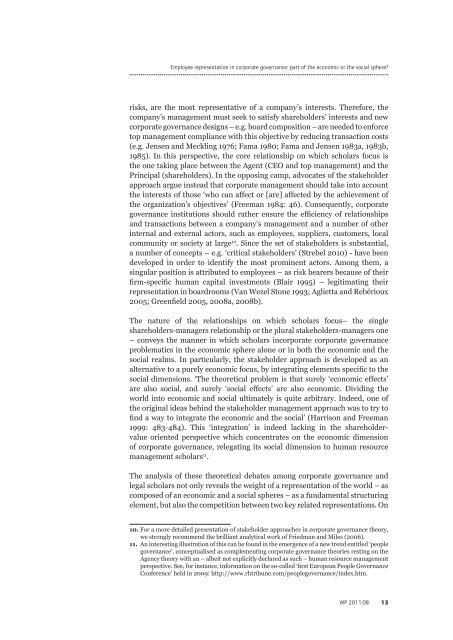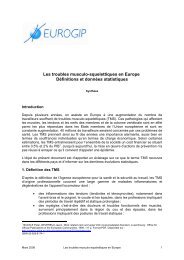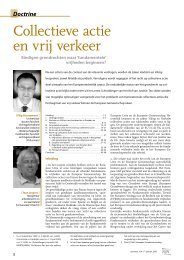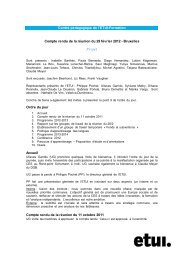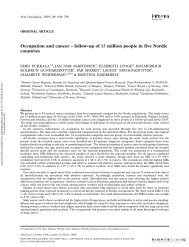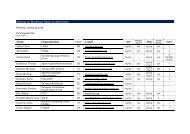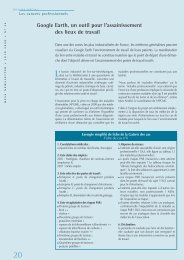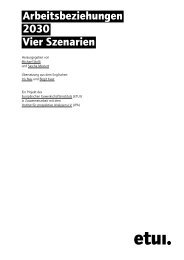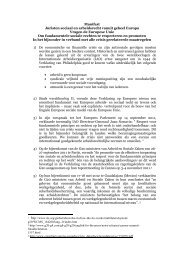Full text - European Trade Union Institute (ETUI)
Full text - European Trade Union Institute (ETUI)
Full text - European Trade Union Institute (ETUI)
You also want an ePaper? Increase the reach of your titles
YUMPU automatically turns print PDFs into web optimized ePapers that Google loves.
Employee representation in corporate governance: part of the economic or the social sphere?<br />
risks, are the most representative of a company’s interests. Therefore, the<br />
company’s management must seek to satisfy shareholders’ interests and new<br />
corporate governance designs – e.g. board composition – are needed to enforce<br />
top management compliance with this objective by reducing transaction costs<br />
(e.g. Jensen and Meckling 1976; Fama 1980; Fama and Jensen 1983a, 1983b,<br />
1985). In this perspective, the core relationship on which scholars focus is<br />
the one taking place between the Agent (CEO and top management) and the<br />
Principal (shareholders). In the opposing camp, advocates of the stakeholder<br />
approach argue instead that corporate management should take into account<br />
the interests of those ‘who can affect or [are] affected by the achievement of<br />
the organization’s objectives’ (Freeman 1984: 46). Consequently, corporate<br />
governance institutions should rather ensure the efficiency of relationships<br />
and transactions between a company’s management and a number of other<br />
internal and external actors, such as employees, suppliers, customers, local<br />
community or society at large 10 . Since the set of stakeholders is substantial,<br />
a number of concepts – e.g. ‘critical stakeholders’ (Strebel 2010) - have been<br />
developed in order to identify the most prominent actors. Among them, a<br />
singular position is attributed to employees – as risk bearers because of their<br />
firm-specific human capital investments (Blair 1995) – legitimating their<br />
representation in boardrooms (Van Wezel Stone 1993; Aglietta and Rebérioux<br />
2005; Greenfield 2005, 2008a, 2008b).<br />
The nature of the relationships on which scholars focus– the single<br />
shareholders-managers relationship or the plural stakeholders-managers one<br />
– conveys the manner in which scholars incorporate corporate governance<br />
problematics in the economic sphere alone or in both the economic and the<br />
social realms. In particularly, the stakeholder approach is developed as an<br />
alternative to a purely economic focus, by integrating elements specific to the<br />
social dimensions. ‘The theoretical problem is that surely ‘economic effects’<br />
are also social, and surely ‘social effects’ are also economic. Dividing the<br />
world into economic and social ultimately is quite arbitrary. Indeed, one of<br />
the original ideas behind the stakeholder management approach was to try to<br />
find a way to integrate the economic and the social’ (Harrison and Freeman<br />
1999: 483-484). This ‘integration’ is indeed lacking in the shareholdervalue<br />
oriented perspective which concentrates on the economic dimension<br />
of corporate governance, relegating its social dimension to human resource<br />
management scholars 11 .<br />
The analysis of these theoretical debates among corporate governance and<br />
legal scholars not only reveals the weight of a representation of the world – as<br />
composed of an economic and a social spheres – as a fundamental structuring<br />
element, but also the competition between two key related representations. On<br />
10. For a more detailed presentation of stakeholder approaches in corporate governance theory,<br />
we strongly recommend the brilliant analytical work of Friedman and Miles (2006).<br />
11. An interesting illustration of this can be found in the emergence of a new trend entitled ‘people<br />
governance’, conceptualised as complementing corporate governance theories resting on the<br />
Agency theory with an – albeit not explicitly declared as such – human resource management<br />
perspective. See, for instance, information on the so-called ‘first <strong>European</strong> People Governance<br />
Conference’ held in 2009: http://www.rhtribune.com/peoplegovernance/index.htm.<br />
WP 2011.08 13


